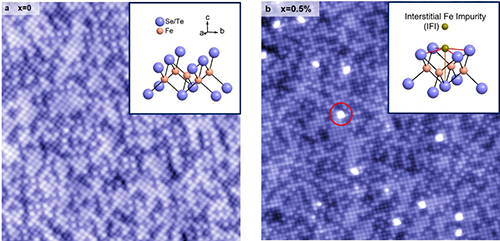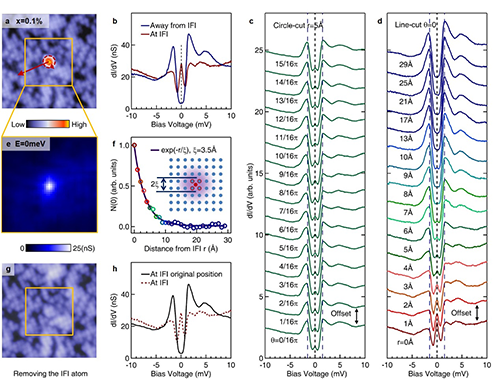A Majorana-like state discovered in the Iron-based Superconductor
Date:11-08-2015 Print
In superconductors, fermionic electrons are paired into bosons, and condensed into the ground state. An impurity can break the electron pairs into quasi-particles with energy states inside the superconducting gap. The characteristics of such in-gap states reflect accordingly the properties of the superconducting ground state. A zero-energy in-gap state is particularly interesting, because it can be the consequence of unconventional pairing symmetry or nontrivial topology.
Scanning Tunnelling Microscopy/Spectroscopy (STM/S) is a powerful technique to study the impurity effect at low temperature with ultra-high spatial and energy resolution. However, the impurity study in recently found Iron-based superconductors is a challenging task, because the cleaving surface of the single crystals of these materials usually contains many kind of impurities and most of impurity-induced state are too weak to do further interpretations. After studying the impurities and impurity-induced states using STM/S for many kinds of iron-superconductor families and over hundreds of samples, recently YIN Jiaxin in Prof. PAN Shuheng and Prof.DING Hong’s groups from Institute of Physics, Chinese Academy of Sciences have discovered a sharp impurity state at the interstitial Fe impurity site in iron superconductor Fe(Te,Se).
They found this impurity state has many unique properties. It is bound to the interstitial Fe impurity with a with a very short decay length of ~ 10 Å. Moreover, it is isotropic and only exists in the superconducting state. More noticeably, this state locates at zero energy and such zero-energy bound state is robust against a magnetic field up to 8 Tesla, as well as perturbations by neighboring impurities. For conventional impurity state, it usually manifest as two peaks, symmetrically with respect to zero energy, and even if the two peaks both happen to be at zero energy, they would be Zeeman-split or shifted away from zero energy by either magnetic field or impurity-impurity interactions. On the other hand, the robust zero-energy bound state bears all the characteristics of the Majorana bound state proposed for topological superconductors, indicating that the superconducting state and the scattering mechanism of the interstitial Fe impurities in Fe(Te,Se) are highly nontrivial.
This study, “Observation of a robust zero-energy bound state in iron-based superconductor Fe(Te,Se)” was published on the Nature Physics on July 1st, 2015. It was supported by the National Science Foundation, the Ministry of Science and Technology of China, and the Chinese Academy of Science and other grants from US.
 |
| Fig.1 Observation of excess Fe impurity at the interstitial position. |
 |
| Fig.2 Interstitial Fe impurity (IFI) induced zero bound state (ZBS). |
 |
| Fig.3 Perturbations of the ZBS by temperature, magnetic field and impurity-impurity interactions. |
Contact:
Institute of Physics
PAN Shuheng
Email: span@iphy.ac.cn
Key word:
Superconductivity; Majorana; zero-energy state;
Abstract:
The symmetry of Cooper pairs in iron-based superconductors is an issue under continued investigation. A scanning tunnelling study of Fe(Te/Se) reveals a robust zero-energy bound state, providing evidence for a non-trivial pairing symmetry.

